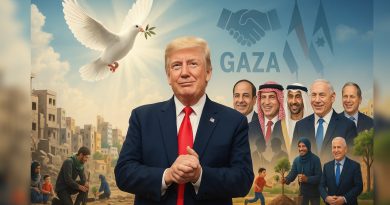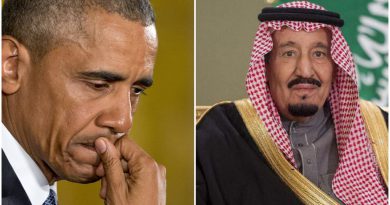Iran responds to US with further aggression
by Dr. Majid Rafizadeh
Iran’s fingerprints are all over these attacks. And this brings us to the second pillar of Iran’s policy, which involves direct military attacks.
Since the Trump administration began exercising its “maximum pressure” policy on the Islamic Republic, Iranian Supreme Leader Ali Khamenei appears to have given the green light for the military to act as it wishes.
In order to alter Iran’s aggressive policies in the Middle East and deter Tehran from obtaining nuclear weapons, the US offered it the chance to come to the negotiating table. The Iranian leaders categorically declined the invitation and threw cold water on the possibility of negotiations in the future.
In a tweet mentioning Japan’s Prime Minister Shinzo Abe, Khamenei wrote: “You said that Trump has said negotiations with the US would lead to Iran’s progress. By the grace of God, without negotiations and despite sanctions, we will progress.” In a meeting with Abe, Khamenei also pointed out that: “I do not consider Trump, as a person, deserving to exchange messages with. We will not negotiate with the United States.”
In order to maximize pressure on the Iranian regime, US President Donald Trump withdrew from the Joint Comprehensive Plan of Action (JCPOA), also known as the Iran nuclear deal, the Department of Treasury reimposed primary and secondary sanctions on Iran’s energy sector and its banking and financial systems; and the Islamic Revolutionary Guard Corps (IRGC) was designated as a terrorist organization.
Nevertheless, Iran appeared determined to continue its destabilizing behavior and the Iranian leaders issued several threats. For example, Rear Adm. Alireza Tangsiri, the head of the IRGC Navy, was last month quotedas saying: “If we are banned from using it (the Strait of Hormuz), we will close it.”
As a result, the US deployed a Patriot missile battery, the USS Abraham Lincoln aircraft carrier, the USS Leyte Gulf guided missile cruiser, Carrier Air Wing Seven, and destroyers from Destroyer Squadron Two to the Middle East in order to deter the Iranian regime from carrying out its threats.
But, instead of coming to the negotiating table and avoiding an escalation, the Iranian regime decided to practice its own version of maximum pressure not only on the US, but also on other countries in the region.
Iran’s equivalent of employing maximum pressure is overwhelmingly anchored in using hard power rather than soft power. There are two crucial pillars to Iran’s policy. The first is instructing its proxies across the region to attack and wreak havoc on entities that are linked to the US, European countries and Gulf states. For example, 40 workers at an ExxonMobil site in southern Iraq had to be evacuated last week after it came under rocket fire.
The Houthi attack on a Saudi oil installation and the rocket that landed near the US Embassy in Baghdad are also being tied to the Iranian regime and its proxies. It was recently leaked that the head of the Quds Force, Gen. Qassem Soleimani, had instructed a conglomerate of more than 40 Iraqi militia groups that operate under the banner of the Popular Mobilization Forces to “prepare for proxy war.”
In the last two months, six oil tankers have been attacked. First, four were targeted close to Fujairah in the UAE. A month later, a pair of tankers transiting the Gulf of Oman off the coast of Iran was sabotaged with explosives — one went up in flames and both were left adrift. Both attacks took place close to the Strait of Hormuz, the narrow waterway that separates Iran and Oman and is one of the most crucial in the world, with about a third of global seaborne-traded oil passing through it.
Iran’s fingerprints are all over these attacks. And this brings us to the second pillar of Iran’s policy, which involves direct military attacks. It is believed that the attacks on the tankers were directly carried out by the Iranian regime because of the high level of sophistication. As US Secretary of State Mike Pompeo pointed out: “This assessment is based on intelligence, the weapons used, the level of expertise needed to execute the operation, recent similar Iranian attacks on shipping and the fact that no proxy group operating in the area has the resources and proficiency to act with such a high degree of sophistication.”
Iran’s direct attacks have also included shooting down a US military drone last week. The head of the IRGC, Maj. Gen. Hossein Salami, said that was a warning to the US, adding that: “The only way for our enemies to be safe is to respect our sovereignty, national security, and the national interests of the great Iranian nation.”
Instead of acting as a rational state, Iran is becoming more aggressive and violent. Tehran is attempting to further destabilize the region in order to impose insecurity and fear and advance the regime’s revolutionary and parochial interests.
Article first published on Arab News.
Dr. Majid Rafizadeh is a Harvard-educated Iranian-American political scientist. He is a leading expert on Iran and US foreign policy, a businessman and president of the International American Council. Twitter: @Dr_Rafizadeh
Disclaimer: Views expressed by writers in this section are their own and do not reflect Milli Chronicle’s point-of-view.



